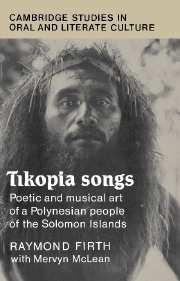Book contents
- Frontmatter
- Contents
- ILLUSTRATIONS
- FIGURES
- Preface
- Acknowledgements
- Sketch map of Tikopia (approx. 5 sq. km.)
- Part I General
- Part II Musical analysis (by Mervyn McLean)
- Part III Song texts, translations and commentary
- 6 Dance songs of everyday life
- 7 Songs of the sea and of travel
- 8 Eulogies and farewells
- 9 Songs of protest and criticism
- 10 Songs of erotic arousal and sex antagonism
- 11 Laments and funeral dirges
- 12 Songs on historical and mythic themes, and of ritual quality
- 13 Epilogue
- Appendix 1 Composers to whom songs attributed
- References
- Index
11 - Laments and funeral dirges
Published online by Cambridge University Press: 07 May 2010
- Frontmatter
- Contents
- ILLUSTRATIONS
- FIGURES
- Preface
- Acknowledgements
- Sketch map of Tikopia (approx. 5 sq. km.)
- Part I General
- Part II Musical analysis (by Mervyn McLean)
- Part III Song texts, translations and commentary
- 6 Dance songs of everyday life
- 7 Songs of the sea and of travel
- 8 Eulogies and farewells
- 9 Songs of protest and criticism
- 10 Songs of erotic arousal and sex antagonism
- 11 Laments and funeral dirges
- 12 Songs on historical and mythic themes, and of ritual quality
- 13 Epilogue
- Appendix 1 Composers to whom songs attributed
- References
- Index
Summary
Songs in this chapter fall broadly into two thematic categories: laments for the living and dirges for the dead. But this categorisation, primarily for purposes of arrangement in publication, does not correspond closely to any Tikopia principle of classification. Nearly all the songs in this chapter are of fuatanga type, that is, sung in slow, what might appear to be doleful style. But as already discussed in Chapter 8, between which and this chapter there is considerable overlap, the fuatanga form is also used for songs of praise. What it represents is an expression of emotional sensitivity in grave manner, in contrast to the gayer manner of a dance song (mako). Even here the classification is not completely exclusive; some mako too may be expressions of gravity. This chapter includes two dance songs. One, composed by Lily, Nau Rangiaco (no. 76) was a lament against her father's apparent neglect of her when she was in hospital; it was couched as a matāvaka probably because it was a kind of mako tauangutu, an accusation which was more suited for expression in dance than in elegy form. The other dance song was also a response to special circumstances. At the obsequies of Noakena, grandson of the Ariki Tafua, in 1929, the old chief and his sons rose to dance a makopo in memory of the boy's recreational activities (no. 82), a grim contrast to the general atmosphere of wailing, yet essentially a traditional funeral performance.
- Type
- Chapter
- Information
- Tikopia SongsPoetic and Musical Art of a Polynesian People of the Solomon Islands, pp. 234 - 248Publisher: Cambridge University PressPrint publication year: 1991



